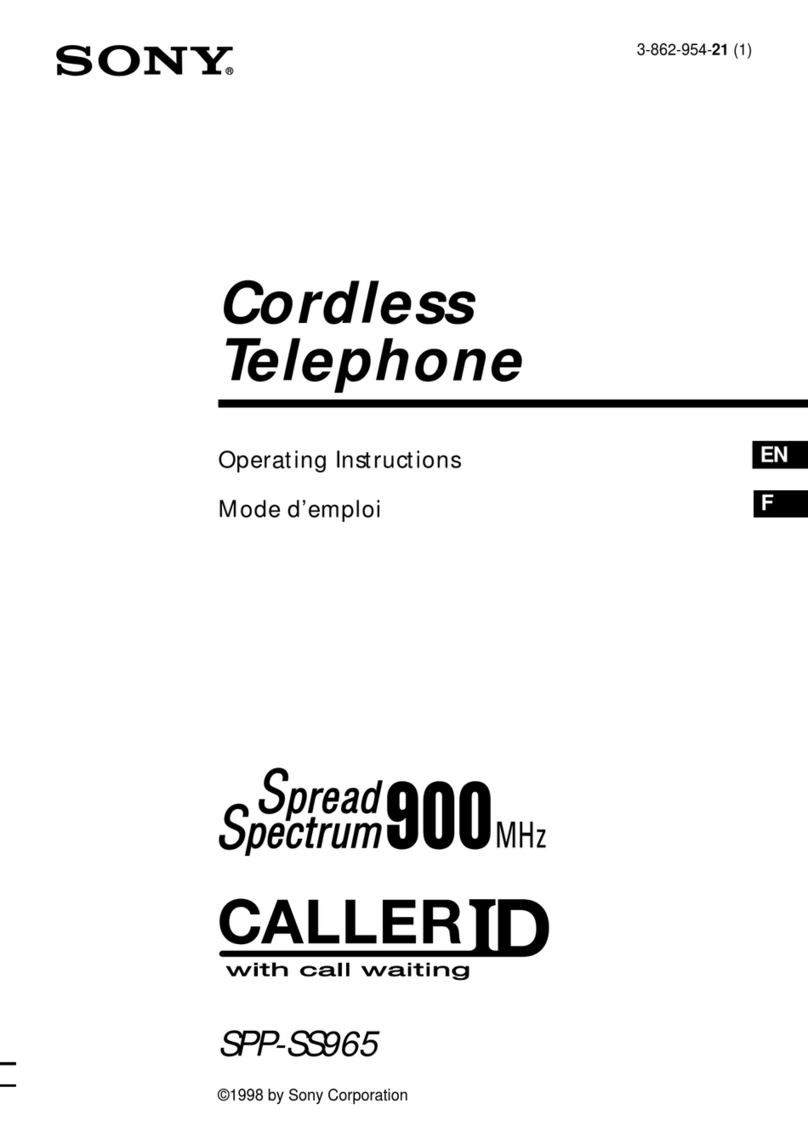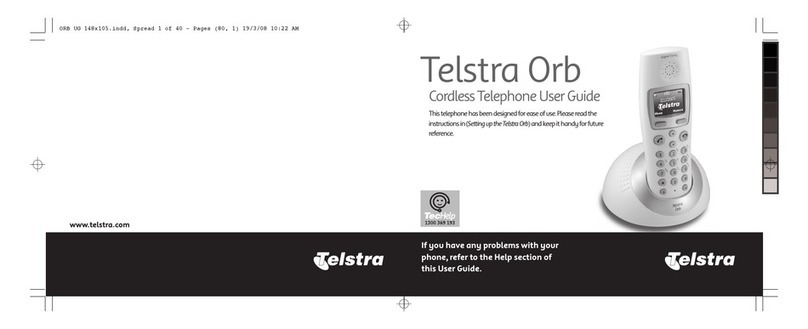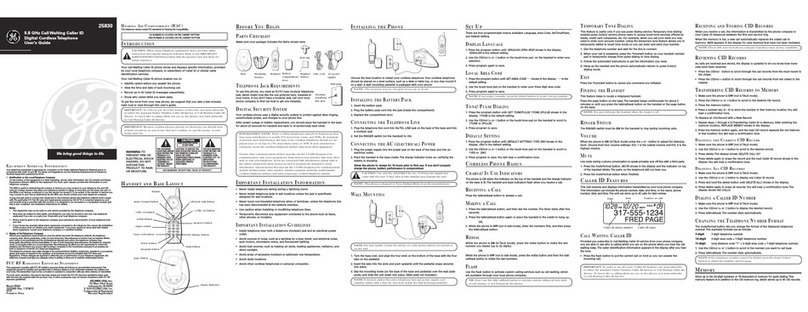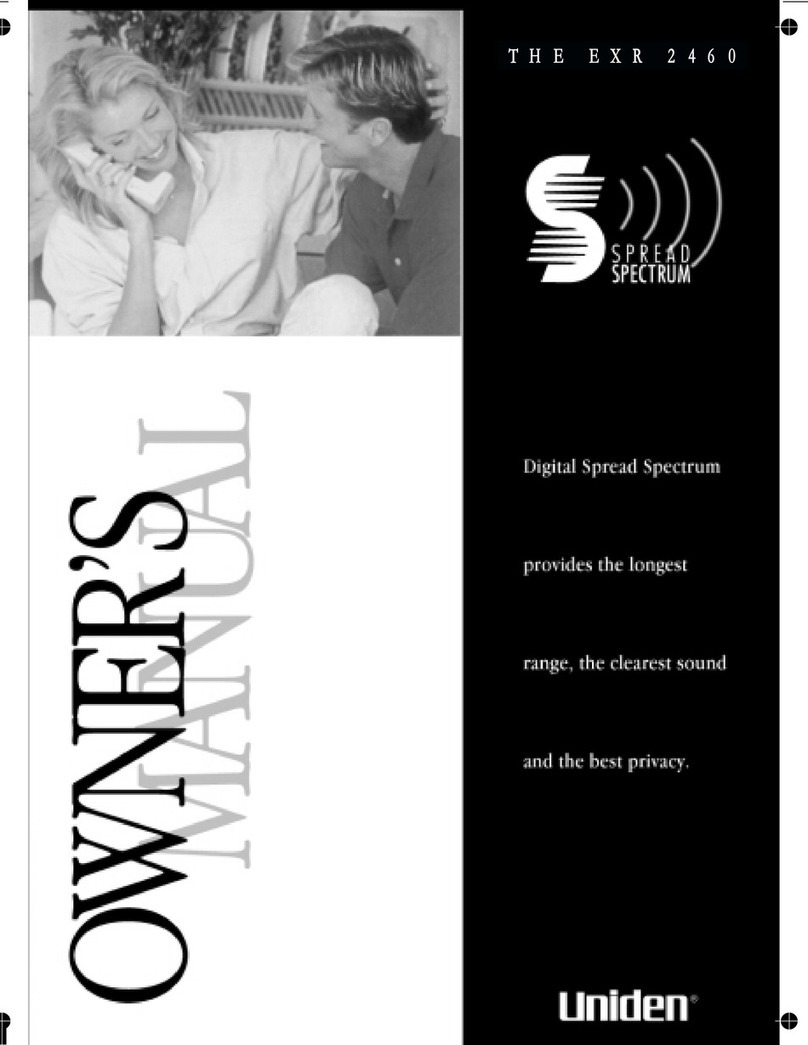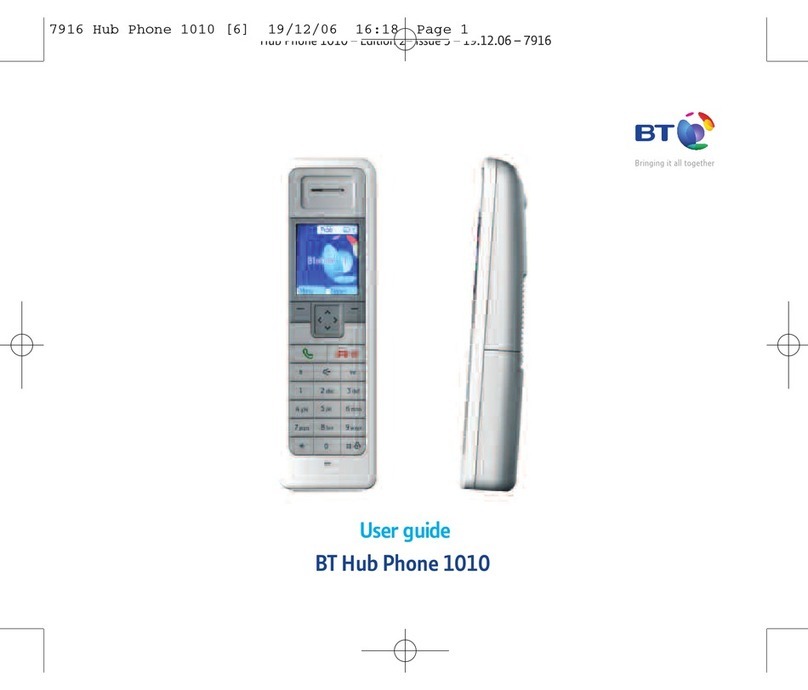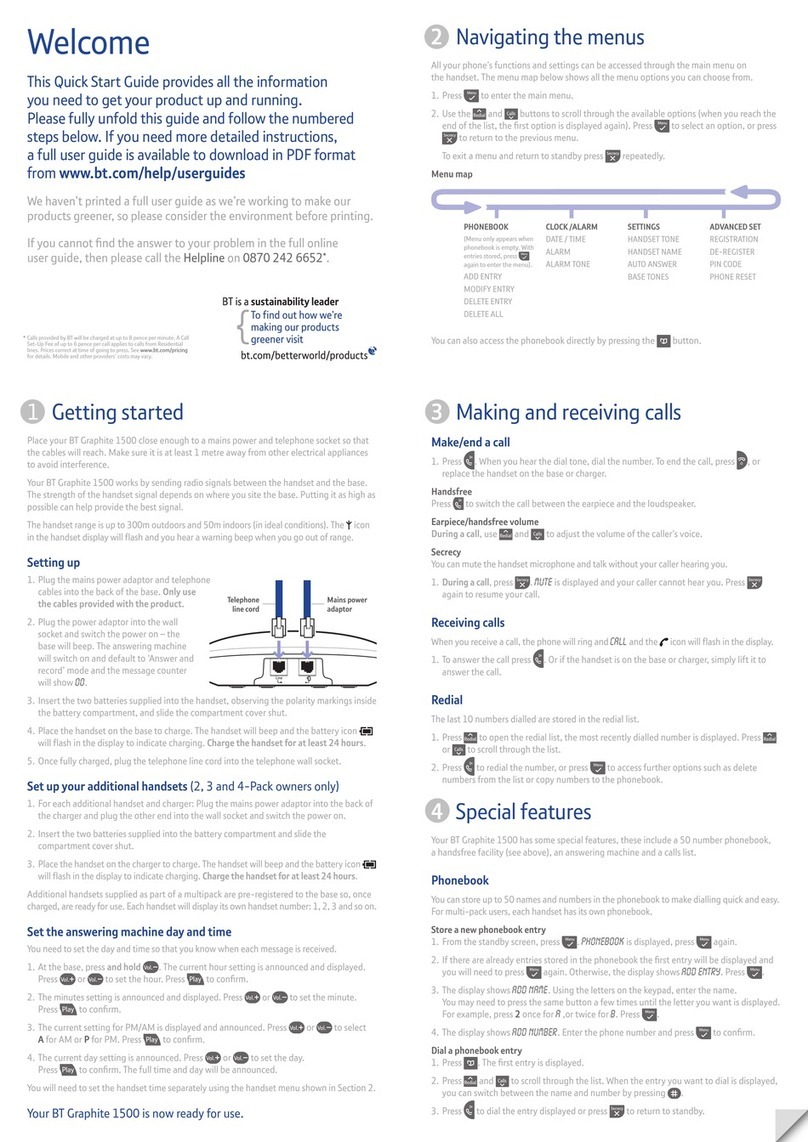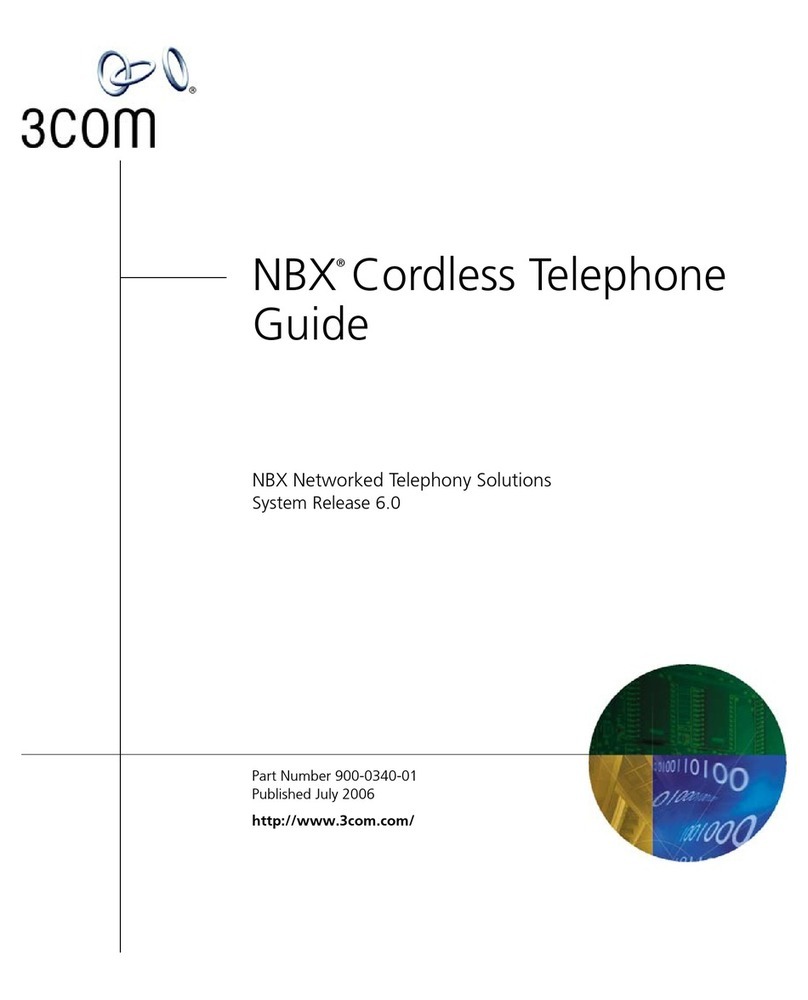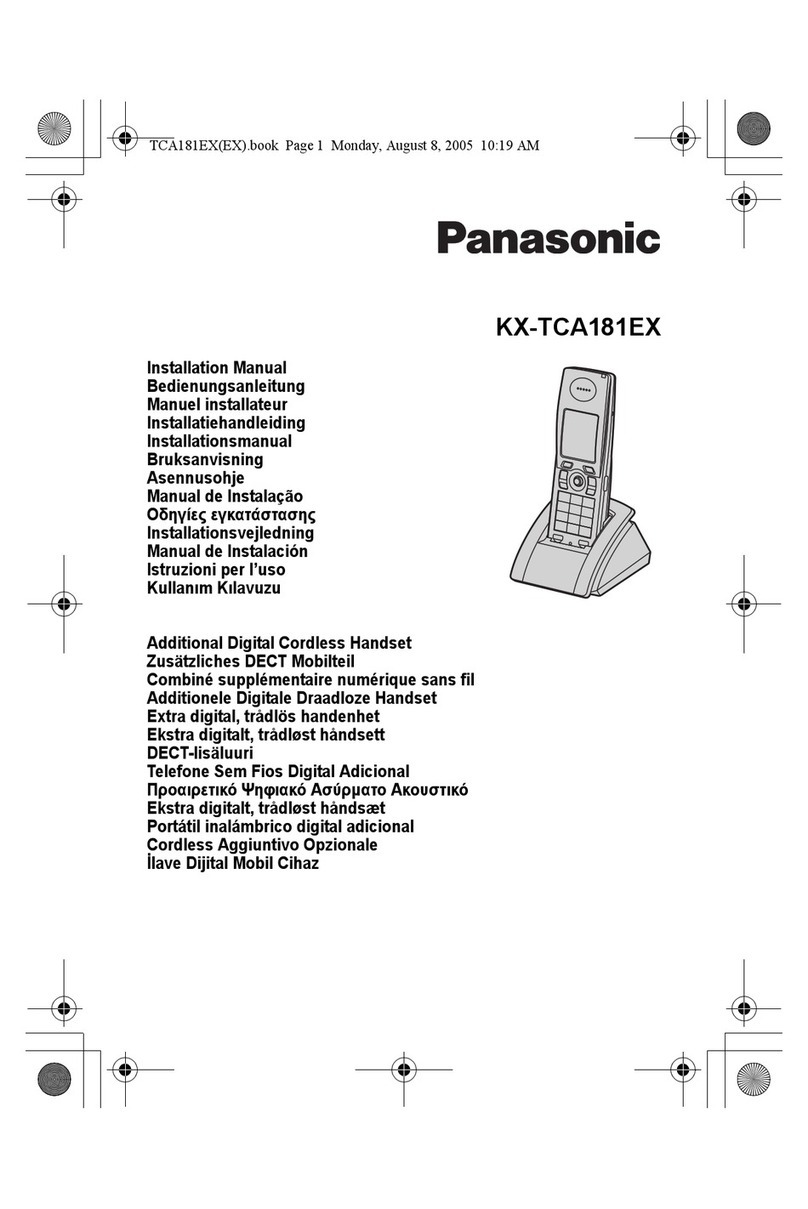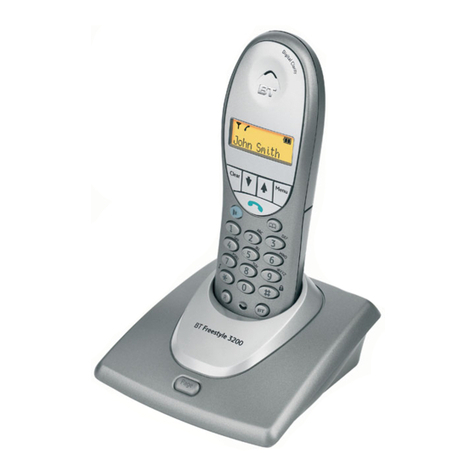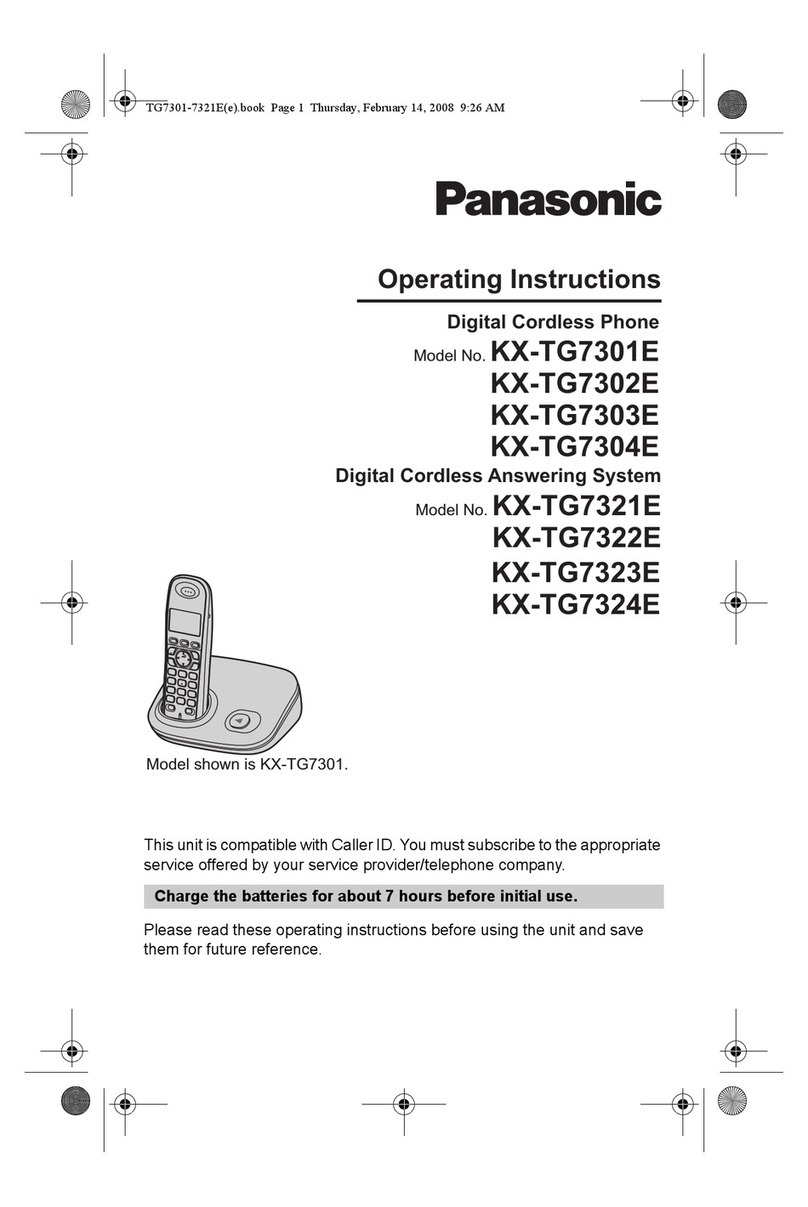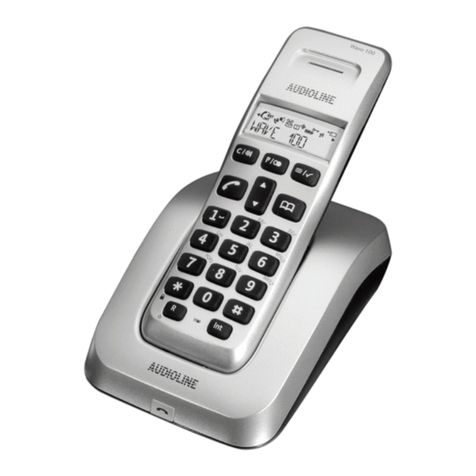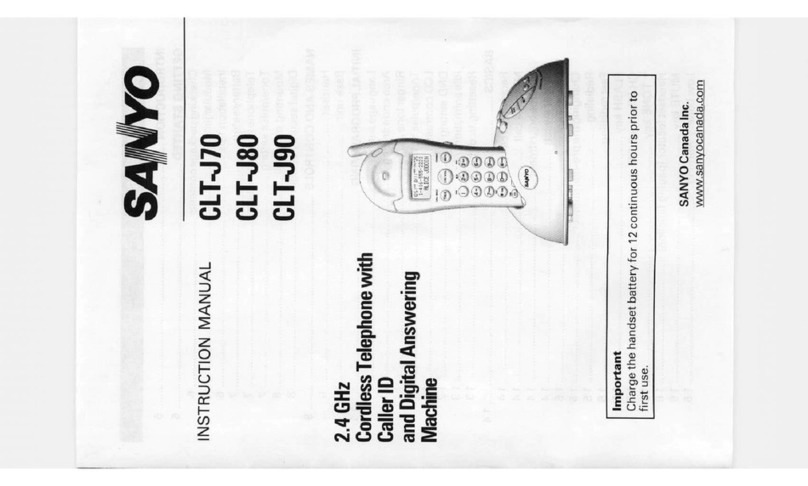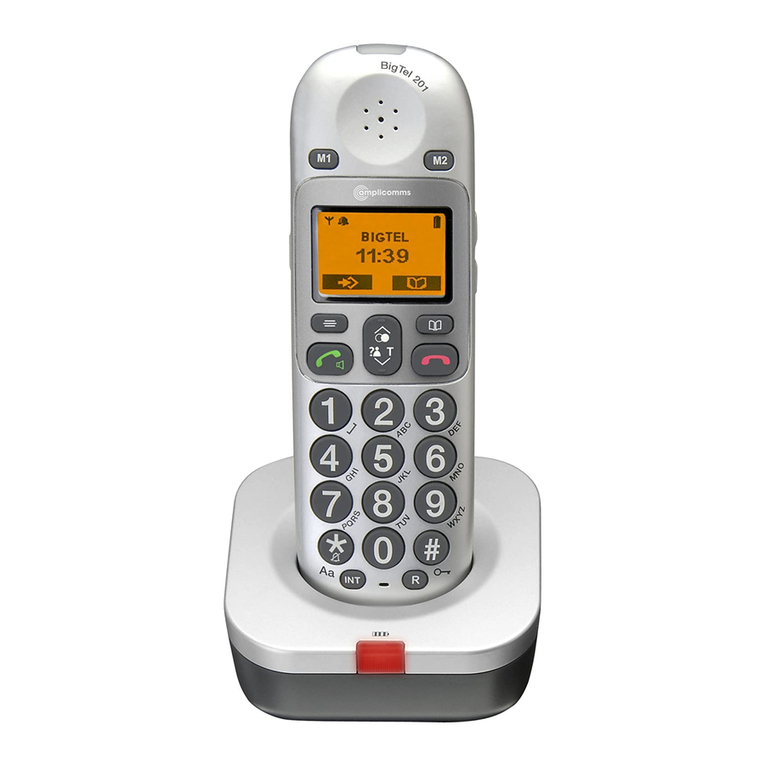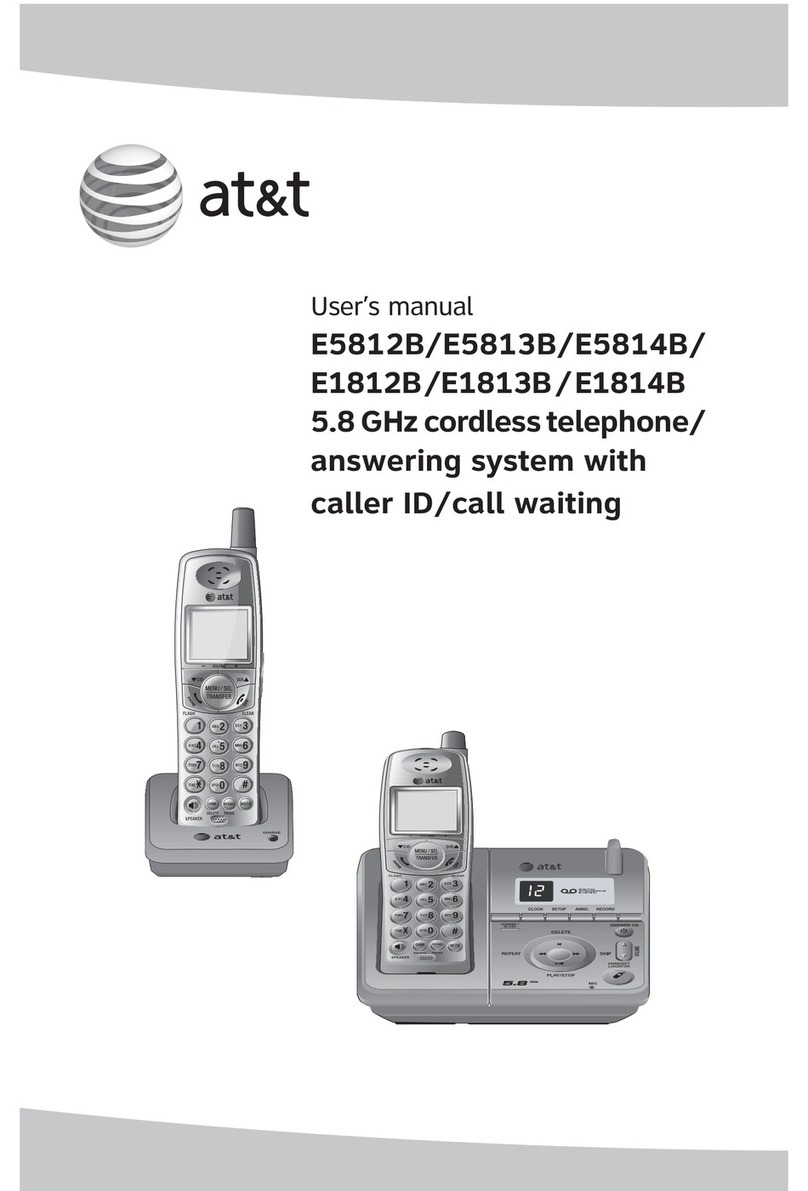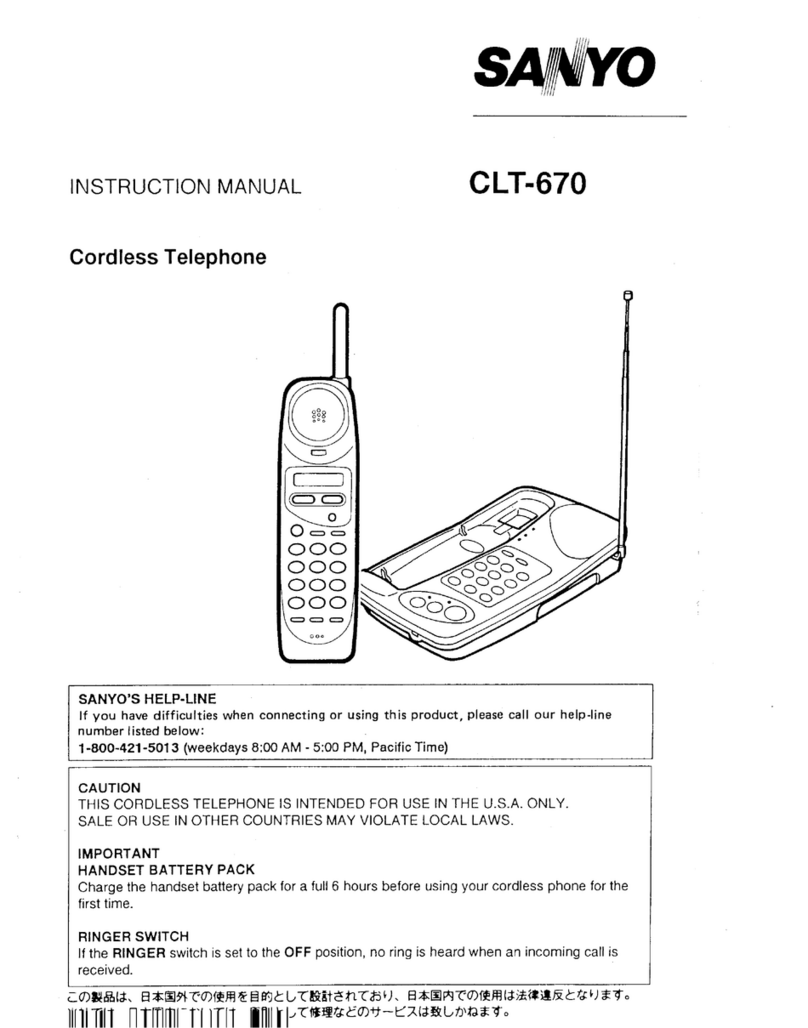T-Home Comfort Pro CM 300 User manual

Comfort Pro CM 300
User Guide

Safety Precautions
Please observe the following notes on safety when setting up, connecting
and using your telephone:
•Place the charging station on a non-slip base.
•You will find further important information on the batteries in the appendix.
• Do not place either the handset or the charging station system
– near heat sources,
– in direct sunlight,
– near other electrical equipment.
•Protect your telephone from moisture, dust, corrosive liquids and fumes.
•Connect to approved accessories only.
• Use the supplied AC adapter (no. 4512132) only.
•Research has shown that in certain cases mobile telephones (DECT) that are
switched on can affect medical equipment. If you are using mobile tele-
phones within a medical establishment, then please observe its regulations.
•Never
– open the telephone yourself!
– touch the plug contacts with pointed, metallic objects!
•Simply wipe your telephone with an anti-static or slightly damp cloth.
• Do not use your telephone in damp rooms (e. g. bathroom) or in areas where
there is a risk of explosion.
Symbols used
General information, useful tip.
Security information, must be observed.
Your telephone is ringing.
Pick up/replace the receiver / Talk on the telephone.
Dial telephone numbers or index numbers.
a
a
…
TIP
!

Contents
Contents
Starting operation of your telephone . . . . . . . . . . . . . . . . . . . . . . . . . . . . . . . . . . . . . . . . . 1
Unpacking and setting up your telephone. . . . . . . . . . . . . . . . . . . . . . . . . . . . . . . . . . . . . . . . . . . 1
Unpacking . . . . . . . . . . . . . . . . . . . . . . . . . . . . . . . . . . . . . . . . . . . . . . . . . . . . . . . . . . . . . . . . . . . . 1
Installing the Charging Station. . . . . . . . . . . . . . . . . . . . . . . . . . . . . . . . . . . . . . . . . . . . . . . . . . . 2
Connecting the Charging Station. . . . . . . . . . . . . . . . . . . . . . . . . . . . . . . . . . . . . . . . . . . . . . . . . . . 3
Adapter plug / Connecting Cable . . . . . . . . . . . . . . . . . . . . . . . . . . . . . . . . . . . . . . . . . . . . . . . . 3
Starting operation of your Handset . . . . . . . . . . . . . . . . . . . . . . . . . . . . . . . . . . . . . . . . . . . . . . . . . 4
Inserting the Battery . . . . . . . . . . . . . . . . . . . . . . . . . . . . . . . . . . . . . . . . . . . . . . . . . . . . . . . . . . . . 4
Charging the Battery . . . . . . . . . . . . . . . . . . . . . . . . . . . . . . . . . . . . . . . . . . . . . . . . . . . . . . . . . . . 5
Handset Subscription (Checking In). . . . . . . . . . . . . . . . . . . . . . . . . . . . . . . . . . . . . . . . . . . . . . 6
Overview of the handset’s operational elements . . . . . . . . . . . . . . . . . . . . . . . . . . . . . . . . . . . 6
Displays, Keys and Symbols . . . . . . . . . . . . . . . . . . . . . . . . . . . . . . . . . . . . . . . . . . . . . . . . . . . . . . . 7
Displays. . . . . . . . . . . . . . . . . . . . . . . . . . . . . . . . . . . . . . . . . . . . . . . . . . . . . . . . . . . . . . . . . . . . . . . 7
Symbols in the Display. . . . . . . . . . . . . . . . . . . . . . . . . . . . . . . . . . . . . . . . . . . . . . . . . . . . . . . . . . 7
Text lines . . . . . . . . . . . . . . . . . . . . . . . . . . . . . . . . . . . . . . . . . . . . . . . . . . . . . . . . . . . . . . . . . . . . . . 8
Softkeys and other keys. . . . . . . . . . . . . . . . . . . . . . . . . . . . . . . . . . . . . . . . . . . . . . . . . . . . . . . . . 8
Quick Switch . . . . . . . . . . . . . . . . . . . . . . . . . . . . . . . . . . . . . . . . . . . . . . . . . . . . . . . . . . . . . . . . . 10
Automatic Hide . . . . . . . . . . . . . . . . . . . . . . . . . . . . . . . . . . . . . . . . . . . . . . . . . . . . . . . . . . . . . . . 10
Switching the Handset On/Off. . . . . . . . . . . . . . . . . . . . . . . . . . . . . . . . . . . . . . . . . . . . . . . . . . . . 11
Switching the Handset Off . . . . . . . . . . . . . . . . . . . . . . . . . . . . . . . . . . . . . . . . . . . . . . . . . . . . . 11
Switching the Handset On . . . . . . . . . . . . . . . . . . . . . . . . . . . . . . . . . . . . . . . . . . . . . . . . . . . . . 11
Speaker / Hands-free Use. . . . . . . . . . . . . . . . . . . . . . . . . . . . . . . . . . . . . . . . . . . . . . . . . . . . . . . . 11
Setting the volume . . . . . . . . . . . . . . . . . . . . . . . . . . . . . . . . . . . . . . . . . . . . . . . . . . . . . . . . . . . . 11
Muting . . . . . . . . . . . . . . . . . . . . . . . . . . . . . . . . . . . . . . . . . . . . . . . . . . . . . . . . . . . . . . . . . . . . . . . . . 12
Visual Call Indicator . . . . . . . . . . . . . . . . . . . . . . . . . . . . . . . . . . . . . . . . . . . . . . . . . . . . . . . . . . . . . 12
Re-dialling . . . . . . . . . . . . . . . . . . . . . . . . . . . . . . . . . . . . . . . . . . . . . . . . . . . . . . . . . . . . . . . . . . . . . 12
Time / Alarm . . . . . . . . . . . . . . . . . . . . . . . . . . . . . . . . . . . . . . . . . . . . . . . . . . . . . . . . . . . . . . . . . . . 12
Telephoning . . . . . . . . . . . . . . . . . . . . . . . . . . . . . . . . . . . . . . . . . . . . . . . . . . . . . . . . . . . . 13
General Information . . . . . . . . . . . . . . . . . . . . . . . . . . . . . . . . . . . . . . . . . . . . . . . . . . . . . . . . . . . . . 13
Internal and External Telephone Numbers . . . . . . . . . . . . . . . . . . . . . . . . . . . . . . . . . . . . . . . 13
Multiple Connections. . . . . . . . . . . . . . . . . . . . . . . . . . . . . . . . . . . . . . . . . . . . . . . . . . . . . . . . . . 13
DTMF Postdial / VF Signalling . . . . . . . . . . . . . . . . . . . . . . . . . . . . . . . . . . . . . . . . . . . . . . . . . . 13

Contents
Display of Call Charges and Call Duration . . . . . . . . . . . . . . . . . . . . . . . . . . . . . . . . . . . . . . . 13
Redialling . . . . . . . . . . . . . . . . . . . . . . . . . . . . . . . . . . . . . . . . . . . . . . . . . . . . . . . . . . . . . . . . . . . . 13
Telephone Lock. . . . . . . . . . . . . . . . . . . . . . . . . . . . . . . . . . . . . . . . . . . . . . . . . . . . . . . . . . . . . . . 14
Blocked / Unblocked Call Numbers. . . . . . . . . . . . . . . . . . . . . . . . . . . . . . . . . . . . . . . . . . . . . 14
Keypad Dialling . . . . . . . . . . . . . . . . . . . . . . . . . . . . . . . . . . . . . . . . . . . . . . . . . . . . . . . . . . . . . . . 14
Least Cost Routing (LCR) . . . . . . . . . . . . . . . . . . . . . . . . . . . . . . . . . . . . . . . . . . . . . . . . . . . . . . 14
Transmission of Call Numbers . . . . . . . . . . . . . . . . . . . . . . . . . . . . . . . . . . . . . . . . . . . . . . . . . . 15
“CLIP“ feature . . . . . . . . . . . . . . . . . . . . . . . . . . . . . . . . . . . . . . . . . . . . . . . . . . . . . . . . . . . . . . . . 15
“CLIP no screening” Feature . . . . . . . . . . . . . . . . . . . . . . . . . . . . . . . . . . . . . . . . . . . . . . . . . . . 15
“CNIP” Feature . . . . . . . . . . . . . . . . . . . . . . . . . . . . . . . . . . . . . . . . . . . . . . . . . . . . . . . . . . . . . . . 15
“CLIR“ feature . . . . . . . . . . . . . . . . . . . . . . . . . . . . . . . . . . . . . . . . . . . . . . . . . . . . . . . . . . . . . . . . 15
Menu Before and During a Call . . . . . . . . . . . . . . . . . . . . . . . . . . . . . . . . . . . . . . . . . . . . . . . . . . . 16
”Selection” Menu in the Idle State. . . . . . . . . . . . . . . . . . . . . . . . . . . . . . . . . . . . . . . . . . . . . . . . . 16
Making Internal/External Calls. . . . . . . . . . . . . . . . . . . . . . . . . . . . . . . . . . . . . . . . . . . . . . . . . . . . 18
Edit pre-dialling . . . . . . . . . . . . . . . . . . . . . . . . . . . . . . . . . . . . . . . . . . . . . . . . . . . . . . . . . . . . . . . . . 18
Making a Call from the Redial List. . . . . . . . . . . . . . . . . . . . . . . . . . . . . . . . . . . . . . . . . . . . . . . . . 19
Making a Call from the Phone Book . . . . . . . . . . . . . . . . . . . . . . . . . . . . . . . . . . . . . . . . . . . . . . . 19
Making a Call from the Call list. . . . . . . . . . . . . . . . . . . . . . . . . . . . . . . . . . . . . . . . . . . . . . . . . . . . 20
”Calling” Menu . . . . . . . . . . . . . . . . . . . . . . . . . . . . . . . . . . . . . . . . . . . . . . . . . . . . . . . . . . . . . . . . . 20
”Busy” Menu . . . . . . . . . . . . . . . . . . . . . . . . . . . . . . . . . . . . . . . . . . . . . . . . . . . . . . . . . . . . . . . . . . . 22
Accepting Calls . . . . . . . . . . . . . . . . . . . . . . . . . . . . . . . . . . . . . . . . . . . . . . . . . . . . . . . . . . . . . . . . . 23
Normal Call . . . . . . . . . . . . . . . . . . . . . . . . . . . . . . . . . . . . . . . . . . . . . . . . . . . . . . . . . . . . . . . . . . 23
External calls with unknown call number . . . . . . . . . . . . . . . . . . . . . . . . . . . . . . . . . . . . . . . . 23
VIP Calls . . . . . . . . . . . . . . . . . . . . . . . . . . . . . . . . . . . . . . . . . . . . . . . . . . . . . . . . . . . . . . . . . . . . . 23
Calls During a Conversation. . . . . . . . . . . . . . . . . . . . . . . . . . . . . . . . . . . . . . . . . . . . . . . . . . . . 24
”Call” Menu . . . . . . . . . . . . . . . . . . . . . . . . . . . . . . . . . . . . . . . . . . . . . . . . . . . . . . . . . . . . . . . . . . . . 24
”Call-waiting” Menu . . . . . . . . . . . . . . . . . . . . . . . . . . . . . . . . . . . . . . . . . . . . . . . . . . . . . . . . . . . . . 25
Telephoning with multiple callers. . . . . . . . . . . . . . . . . . . . . . . . . . . . . . . . . . . . . . . . . . . 26
Enquiry, Toggle, Transfer and Conference. . . . . . . . . . . . . . . . . . . . . . . . . . . . . . . . . . . . . . . . . . 26
Enquiry / Toggling by Means of the R-Key. . . . . . . . . . . . . . . . . . . . . . . . . . . . . . . . . . . . . . . . 26
Transferring an Internal/External Call to an Internal Subscriber. . . . . . . . . . . . . . . . . . . . . 27
Transferring an External Call to an External Subscriber . . . . . . . . . . . . . . . . . . . . . . . . . . . . 27
Internal/External 3-Party Conference . . . . . . . . . . . . . . . . . . . . . . . . . . . . . . . . . . . . . . . . . . . . 28
The”Dial” menu for consultations . . . . . . . . . . . . . . . . . . . . . . . . . . . . . . . . . . . . . . . . . . . . . . . . . 29

Contents
”Subscriber on Hold” Menu . . . . . . . . . . . . . . . . . . . . . . . . . . . . . . . . . . . . . . . . . . . . . . . . . . . . . . 30
”Conference” Menu . . . . . . . . . . . . . . . . . . . . . . . . . . . . . . . . . . . . . . . . . . . . . . . . . . . . . . . . . . . . . 31
Special Calls / Conversations. . . . . . . . . . . . . . . . . . . . . . . . . . . . . . . . . . . . . . . . . . . . . . . . . . . . . 33
Baby Call . . . . . . . . . . . . . . . . . . . . . . . . . . . . . . . . . . . . . . . . . . . . . . . . . . . . . . . . . . . . . . . . . . . . 33
Doorbell, Entrance Intercom Call, Door Opener. . . . . . . . . . . . . . . . . . . . . . . . . . . . . . . . . . . 33
Announcements (with and without Intercom). . . . . . . . . . . . . . . . . . . . . . . . . . . . . . . . . . . . . 34
Answering a Callback . . . . . . . . . . . . . . . . . . . . . . . . . . . . . . . . . . . . . . . . . . . . . . . . . . . . . . . . . 35
Making Calls from the Telephone Book. . . . . . . . . . . . . . . . . . . . . . . . . . . . . . . . . . . . . . 36
Your Communications System’s Telephone Book . . . . . . . . . . . . . . . . . . . . . . . . . . . . . . . . . . . 36
”Phone book” Menu. . . . . . . . . . . . . . . . . . . . . . . . . . . . . . . . . . . . . . . . . . . . . . . . . . . . . . . . . . . . . 36
Speed-Dialling. . . . . . . . . . . . . . . . . . . . . . . . . . . . . . . . . . . . . . . . . . . . . . . . . . . . . . . . . . . . . . . . 37
Features and Menus . . . . . . . . . . . . . . . . . . . . . . . . . . . . . . . . . . . . . . . . . . . . . . . . . . . . . 38
How to Set Features . . . . . . . . . . . . . . . . . . . . . . . . . . . . . . . . . . . . . . . . . . . . . . . . . . . . . . . . . . . . . 38
”Main menu” . . . . . . . . . . . . . . . . . . . . . . . . . . . . . . . . . . . . . . . . . . . . . . . . . . . . . . . . . . . . . . . . . . . 38
”Calls” Menu . . . . . . . . . . . . . . . . . . . . . . . . . . . . . . . . . . . . . . . . . . . . . . . . . . . . . . . . . . . . . . . . . . . 39
”Call forwarding” Menu . . . . . . . . . . . . . . . . . . . . . . . . . . . . . . . . . . . . . . . . . . . . . . . . . . . . . . . . . . 42
”Messages” Menu. . . . . . . . . . . . . . . . . . . . . . . . . . . . . . . . . . . . . . . . . . . . . . . . . . . . . . . . . . . . . . . 44
”Phone settings” Menu . . . . . . . . . . . . . . . . . . . . . . . . . . . . . . . . . . . . . . . . . . . . . . . . . . . . . . . . . . 46
”Protection” Menu. . . . . . . . . . . . . . . . . . . . . . . . . . . . . . . . . . . . . . . . . . . . . . . . . . . . . . . . . . . . . . . 50
”Connections” Menu . . . . . . . . . . . . . . . . . . . . . . . . . . . . . . . . . . . . . . . . . . . . . . . . . . . . . . . . . . . . 51
”Phone book” Menu. . . . . . . . . . . . . . . . . . . . . . . . . . . . . . . . . . . . . . . . . . . . . . . . . . . . . . . . . . . . . 52
”Applications” Menu. . . . . . . . . . . . . . . . . . . . . . . . . . . . . . . . . . . . . . . . . . . . . . . . . . . . . . . . . . . . . 53
”Central settings” Menu. . . . . . . . . . . . . . . . . . . . . . . . . . . . . . . . . . . . . . . . . . . . . . . . . . . . . . . . . . 54
”Info” Menu . . . . . . . . . . . . . . . . . . . . . . . . . . . . . . . . . . . . . . . . . . . . . . . . . . . . . . . . . . . . . . . . . . . . 55
”Active features” Menu. . . . . . . . . . . . . . . . . . . . . . . . . . . . . . . . . . . . . . . . . . . . . . . . . . . . . . . . . . . 56
Updating the Software. . . . . . . . . . . . . . . . . . . . . . . . . . . . . . . . . . . . . . . . . . . . . . . . . . . . 57
Appendix. . . . . . . . . . . . . . . . . . . . . . . . . . . . . . . . . . . . . . . . . . . . . . . . . . . . . . . . . . . . . . . 58
Important Information About the Battery . . . . . . . . . . . . . . . . . . . . . . . . . . . . . . . . . . . . . . . . . . . 58
Technical Data . . . . . . . . . . . . . . . . . . . . . . . . . . . . . . . . . . . . . . . . . . . . . . . . . . . . . . . . . . . . . . . . . . 60
Notifications and error messages . . . . . . . . . . . . . . . . . . . . . . . . . . . . . . . . . . . . . . . . . . . . . . . . . 61
Main Menu . . . . . . . . . . . . . . . . . . . . . . . . . . . . . . . . . . . . . . . . . . . . . . . . . . . . . . . . . . . . . . . . . . . . . 62
Index . . . . . . . . . . . . . . . . . . . . . . . . . . . . . . . . . . . . . . . . . . . . . . . . . . . . . . . . . . . . . . . . . . . . . . . . . . 63


1
Starting operation of your telephone
Starting operation of your telephone
Unpacking and setting up your telephone
Unpacking
Scope of Delivery Comfort Pro CM 300 handset
•ahandset
•three batteries
• belt clip
• cable for software updates
The charging station package includes
•acharging station
•a230 V AC adapter plug with a connecting cable
Depending on the digital transmission in the frequency range used and also on the
technical environment within the range of coverage, silent zones may occur. In this
case, transmission quality can be diminished by multiple, short transmission gaps.
Slight movement out of the silent zone will restore typical transmission quality. The
connection will be lost if the handset is moved out of range.
In order to avoid radio coupling into other electronic equipment, we recommend the
maximum possible distance (min. 1m) between the charging station / handset and
other devices (e. g. radios, loudspeakers etc.)
The CE symbol on the product confirms that it meets the technical guidelines on user
safety and electromagnetic compatibility valid at the time of issue of the correspon-
ding conformity declaration (see Appendix) in line with European Directive
de.99/5/EC.
Before using the handset, people with hearing aids should note that radio signals can
couple into hearing aids and if strong enough can cause an unpleasant buzzing
sound.
!

2
Starting operation of your telephone
Installing the Charging Station
Your telephone was made for use in normal conditions. Modern furniture is coated with a huge range
of different paints, varnishes and plastics and treated with various products to protect and maintain
these surfaces. It is possible that some of these substances may contain ingredients that attack the
plastic of the charging station, causing it to soften. The bases of devices affected by such substances
may leave unpleasant marks on furniture surfaces.
Deutsche Telekom AG cannot accept any liability for any damage caused in this way.
Please provide your telephone with a non-slip base, especially if is it to be placed on new furniture or
on furniture treated with protective substances.

3
Starting operation of your telephone
•Please do not install the charging station around the openings of doors or windows: it
may be damaged!
•Use only the adapter plug unit provided, No. 4512132, for the charging station.
Adapter plug / Connecting Cable
Connect the cable of the adapter plug to the socket on the underside of the charging station, and then
insert the adapter plug into the mains socket.
Pull the power cord out of the 230 V power point before removing the adapter plug.
!
!
Connecting the Charging Station

4
Starting operation of your telephone
Your handset is ready for use once the batteries have been charged for the first time. You can now use
the handset to make and accept calls.
Inserting the Battery
On the underside of the handset there is a battery compartment for the batteries of the type AAA
(Micro cell) provided.
You will find important information on handling the batteries in the appendix (see
page 58).
Opening the battery compartment:
Open the lid of the battery compart-
ment as shown here.
Inserting the Battery (observe
polarity):
Observe the correct polarity when
replacing the batteries. The + - sym-
bols in the battery compartment must
correspond to the + - symbols of the
batteries.
Replace the lid of the battery com-
partment at a slight angle and close it
so that it snaps shut.
If the batteries are incorrectly inserted, the handset will not work and damage may
occur.
!
!
Starting operation of your Handset
1
2
1
2

5
Starting operation of your telephone
Charging the Battery
When the telephone is unpacked, the batteries are not yet charged. To charge the batteries, place the
handset in the charging station. You can see the batteries‘ charging status in the number of blinking or
constantly illuminated segments in the upper line of the display. The higher the number of constantly
illuminated battery segments, the more fully the batteries are charged. Empty batteries take about 5 to
6 hours to charge fully.
Batteries with an unknown charging status are fully charged in approx. 14 hours.
The charging status of the battery is shown in the display as follows (when the handset is not in the
charging station):
† Frame flashes – Battery nearly discharged
† ”0 - 20 %” charged
… ”21 - 40 %” charged
√ ”41 - 60 %” charged
„ ”61 - 80 %” charged
ƒ ”81 - 100 %” charged
The maximum performance of the batteries is only reached after several charging/discharging cycles.
When only the frame of the battery symbol blinks and the four segments are constantly illuminated,
the batteries are fully charged.
You can telephone for up to 20 hours on fully-charged batteries. Stand-by time for the handset when
not in the charging station is up to 200 hours.
When the battery capacity is nearly exhausted, the battery symbol ( †)will flash in the display. If you
are making a call at the time, you still have up to three minutes of talk time before the handset switches
itself off.
If you are not making a call and the handset is not in the charging station, .appears
in the display. You can no longer make a telephone call now.
Please note that the battery display needs to undergo several charging cycles after
new batteries are inserted before it can provide you with correct information on their
charging status.
Use only NiMH rechargeable batteries. Never use normal batteries / primary cell bat-
teries (see page 58).
You can replace your handset in the charging station after every call. The charging
process is electronically controlled to ensure that the batteries are optimally charged
starting from their respective charging status. Do not take the batteries out of the
handset without a good reason, since this may prevent optimal charging.
You can improve the capacity of your batteries by completely discharging and then
completely recharging the batteries in the handset after long periods in operation.
TIP
!
!
Battery empty

6
Handset Subscription (Checking In)
Your handset can be operated in up to ten different communications systems. To be able to do this, it
must be subscribed to every system, this means: the handset must be checked in.
If you are operating your handset in the Comfort Pro communications system, checking in your hand-
set will be done by your system administrator.
Overview of the handset’s operational elements
Starting operation of your telephone
Display
Earpiece
Softkey Softkey
Info key
R-key
Call key
Loudspeaker key
Number keys
Cancel key
Microphone
Arrow keys

7
Starting operation of your telephone
Displays, Keys and Symbols
Displays
The display shows you your telephone‘s current status and leads you in a comprehensible way
through its operations.
Symbol/Text line
System name with internal call number
Programmed user name
Time
Softkey line
Symbols in the Display
Quality of the radio connection (four bars means a stable radio connection; a single bar
means an unstable radio connection).
Call state (call key pressed).
Call state (speaker/hands-free activated).
Microphone switched off.
You have received e-mail messages.
Ringer switched off.
You have received a voicebox message. This requires the integrated answering machine
Comfort Pro IAB to be connected to your communications system. The symbol is only visible
if there is no active connection to the communications system.
You have programmed and activated a local alarm.
Battery charging status. Four segments indicate full or nearly full batteries. If only the frame is
visible and is blinking, you should place your handset in the charging station for recharging.
You have activated the keypad lock. This symbol appears when the keypad lock is activated
above the left softkey (an where the redial symbol appears ¤).
œ ¢ ƒ
Comfort Pro CM 300
Peters
π10:00
¤¬Menu
œ
¢
»
‡
‚
‹
≥
©
ƒ
º

8
Starting operation of your telephone
Text lines
The text lines provide information on the current call status or menu lists and texts. In the idle state, the
display shows the system name and internal call number, your programmed user name and the time.
Selection lists (e. g. telephone book) and the features menu are displayed in a three-line section of the
display. The lines are scrolled up or down by means of the arrow keys. An item that can be selected is
highlighted in a dark colour.
Softkeys and other keys
The two keys below the display, as well as the arrow keys, are known as softkeys. The functions
assigned to the keys are shown in the lowest line of the display. The key function changes automati-
cally according to the operating status of the handset.
Above the arrow keys you will see symbols that identify the individual functions of the arrow keys:
{}When you are entering telephone numbers or names, you can make changes
by moving the cursor. The arrow keys then move the cursor to the beginning
or the end of the entry.
¤Enables selection from the redial list.
¬Enables selection of numbers from the telephone book.
‘Where a list is displayed, (e.g. telephone book or menu, move the cursor with
the arrow keys to the desired entry.
Handset /Loudspeaker /Headset
Volume symbol
Softkey: OK
Press OK to confirm the selected function. If a function only has one quickswitch
option, it is operated by this key. Active settings (ON) are indicated by a “✔”
behind the relevant item; inactive settings (OFF) are indicated by a “–”.
PABX Menu
Calls
Call diversion
Messages
OK ‘ ESC

9
Softkey: ESC
Press the ESC softkey briefly to exit the section of the menu currently displayed.
You will then see the selection from the previous menu or the current idle or call
display.
Call Key - The call key has the same function as lifting or replacing the receiver of
a normal telephone.
Loudspeaker Key - This key activates the speaker or hands-free mode. This key
lights up when the loudspeaker / hands-free mode is activated.
Info Key - By means of this key you can access the various lists (e. g. the call list)
as well as view and change currently activated features (e. g. call protection). If
there are new calls, e-mails, short messages or voicebox messages, then the Info
key flashes.
Cancel Key - This key cancels your menu selection without saving the previous
entry. If you are entering numbers or letters, this key deletes the last character.
Pressing and holding the key deletes the complete entry.
Start a consultation during a connection.
Number Keys - The number keys are used to directly enter telephone numbers
and names, including Vanity phone numbers.
In input lines for text, the numerical keypad automatically switches to the entry of
letters. You can enter the following characters by pressing the number keys sev-
eral times:
KeyUpper-case letter Lower-case letter
11? ! , . : ; ” ‘ 1 ? ! , . : ; ” ‘
2ABC 2 Ä Å À Á Ã Æ Ç a b c 2 ä å à á ã æ ç
3DE F 3 È É Ê Ë €d e f 3 è é ê ë €
4GH I 4 Í Ì Î Ï g h i 4 í ì î ï
5JK L 5 j k l 5
6MNO 6 Ö Ñ Ò Ó Ô Õ Ø m n o 6 ö ñ ò ó ô õ ø
7PQR S 7 ß p q r s 7 ß
8TU V 8 Ü Ù Ú Û t u v 8 ü ù ú û
9WX Y Z 9 w x y z 9
00(space) @ $ & 0 (space) @ $ &
**
- + = ~ < > ^ % *- + = ~ < > ^ %
##( ) { } [ ] / \ # ( ) { } [ ] / \
When entering text, you can use the arrow keys to move the cursor to the
beginning or end of the entry.
•Inputs are always made to the immediate left of the cursor position.
•The input position moves automatically if you pause briefly between your
inputs or if you enter a new character.
•When entering text, the first letter will automatically be upper case, the
remaining letters automatically lower case. After you enter a space, the next
letter will be upper case once again.
Starting operation of your telephone
…

10
Starting operation of your telephone
•While entering text, you may switch back and forth between upper and lower
case by pressing a number key for a longer time. The upper-/lower-case
remains activated until the next time you press a number key longer.
•Ashort press of the C key deletes individual digits/characters (in front of
the cursor), whereas long pressing the key deletes the complete entry.
•The Esc key cancels the entire procedure.
Hash key for entering the ”hash ” -symbol.
Star key for entering the ”star” -symbol.
Quick Switch
A ”+” preceding the name of a feature indicates that it is active, and a ”-” that it has been switched off.
If you press OK, a switch window appears.
Automatic Hide
Menus are automatically hidden under the following circumstances:
•In the call state, when you make inputs performing a function (e. g. when you initiate a conference,
see the section on ”Telephoning with multiple callers”, page 26).
•When a softkey invoking a menu other than the one displayed is pressed.
If you are in a menu when someone attempts to call you, the caller hears the busy signal. You exit
the menu automatically when you make no inputs for a time.
Inputs already saved in menus remain saved when you exit the menus.

11
Starting operation of your telephone
Switching the Handset On/Off
After the batteries have been charged for the first time, your handset is automatically switched on and
ready for use. You can switch off your handset to maintain the charged status of your batteries for
longer.
Switching the Handset Off
You can switch the handset off by pressing the C key for longer than one second
in the idle state.
No ringer or alarm signal is emitted while the handset is switched off.
Switching the Handset On
You switch it on by pressing the C key again or by placing the handset in the
charging station.
No ringer or alarm signal is emitted while the handset is switched off.
Speaker / Hands-free Use
To allow several people in the same room to take part in a call, press the loud-
speaker key during a call. Repeat to switch off.
You will achieve the best quality when the handset is in a vertical position; in
other words when neither the loudspeaker nor the microphone are covered.
Setting the volume
During a call you can adjust the speaker or loudspeaker volume to one of seven
levels. You can monitor the setting in the display.
!
!

12
Starting operation of your telephone
Muting
During a call you can switch your handset’s microphone off with .
switches it back on.
Visual Call Indicator
The receiver symbol in the display flashes and the display illumination is switched on to indicate an
incoming call.
Re-dialling
The last 50 external telephone numbers you dialled are stored in the redial list. When ten entries are
exceeded, the oldest number is replaced.
Time / Alarm
In the idle state, the display shows the current communications system’s time. The time is automati-
cally updated after an external call. After going into operation for the first time or changing the batter-
ies, it can take a moment before the Comfort Pro communications system transmits the current time.
The handset also has a programmable alarm function. For details, please refer to page 48.
Unmute Mute

13
Telephoning
Telephoning
General Information
Internal and External Telephone Numbers
The internal and external telephone numbers at which you can be reached are assigned when your
Comfort Pro communications system is set up.
Multiple Connections
Two calls can be made on your handset simultaneously. Any further callers will hear a busy signal.
DTMF Postdial / VF Signalling
In the connection state your telephone is automatically set to VF (voice frequency) signalling. You can
use this, for example, to query an answering machine or a voicebox.
Display of Call Charges and Call Duration
If your network operator transmits call charge information, and if you have dialled an external number
yourself, you will see the amount of the charge for this call during the call or after you hang up.
Redialling
Press the left softkey in the idle state ¤. The last 50 telephone numbers you dialled are stored in the
redial list.
If a telephone number is also in the phone book/list of names of your system, the name will appear.
Dial: Press the call key, and the telephone number selected
will be dialled.
Additional possibilities:
Press OK to see a selection menu enabling you to dial the
selected number from the redial list, to delete the number, or
to delete all numbers from the redial list.
Telephone Lock
You can switch the telephone lock on or off using the ”Protection – Telephone lock” menu after enter-
ing your PIN. Switching on the telephone lock changes dialling rights. You may no longer be able to
make external calls or only make them to a limited extent.
Redial list
Peters
Newmann
30011
OK §¨ ESC

14
Telephoning
Blocked / Unblocked Call Numbers
Your telephone can be blocked from dialling all or selected external call numbers.
Emergency numbers (e. g. in Germany 110/112) can always be dialled. Consult your
system administrator for details.
Keypad Dialling
A number of European network operators need the keypad protocol in order to set features. In that
case, you must switch your telephone over to the keypad protocol – before dialling – and enter the
code digits specified by the network operator. These are transmitted directly to the exchange and eval-
uated there. You usually get an announcement as an acknowledgement.
This switches your telephone over to the keypad protocol. You can now enter the code digits for the
appropriate keypad.
The setting is deleted again when the connection is terminated!
Least Cost Routing (LCR)
Whenever you make an external call, your system automatically uses LCR to set up a connection to a
network operator that has been selected by the system administrator. If you do not want to use this pre-
ferred connection, then before your call, select from the menu, as described in the
following section. Ask your System Administrator if LCR has been set up for you.
Baby call and external call forwarding are not automatically routed via preferred con-
nections. In this case, if the network operator you wish to use is not the default opera-
tor, you must prefix the desired telephone number with the operator’s code.
Transmission of Call Numbers
In ISDN there are various services enabling and disabling the transmission of telephone numbers
between subscribers.
“CLIP“ feature
CLIP is an abbreviation for “Calling Line Identification Presentation”. The caller’s telephone number (if
transmitted) is displayed. If this number is also stored in the system’s telephone book, the caller’s
name is displayed.
!
LCR off
!
!
Table of contents
Other T-Home Cordless Telephone manuals

